Yorkshire terriers are very energetic and cheerful dogs. It is hard to imagine that such a funny doggie staggeringly walks alongside the owner and silently looks at the people passing by. Usually yorks are fun jumping, yapping and scurrying around all the time. Such fidgets especially need training, otherwise the pet may become simply uncontrollable. Learn how to properly educate these little active dogs so that they grow balanced and bring only positive emotions to the owner and others.
Features
Having taken the baby to his house, the new owner does not even suspect about the explosive nature inherent in his pet. York is a leader by nature, despite such a small size it is characterized by courage and curiosity. However, this is a very friendly dog, he is able to give the owner love and tenderness. The owner’s task is to achieve a middle ground in his behavior so that the dog’s activity does not acquire aggressive forms and gets the right direction.
The education of York should begin as early as possible. Then your relationship will develop in the right way, and the dog will listen to you, and not consider him a secondary friend. Starting with the basics, over time you will be able to master more and more complex teams.


Parenting recommendations
To train York, you do not need special skills. These animals are smart enough to understand what they want from them, and can be obedient.
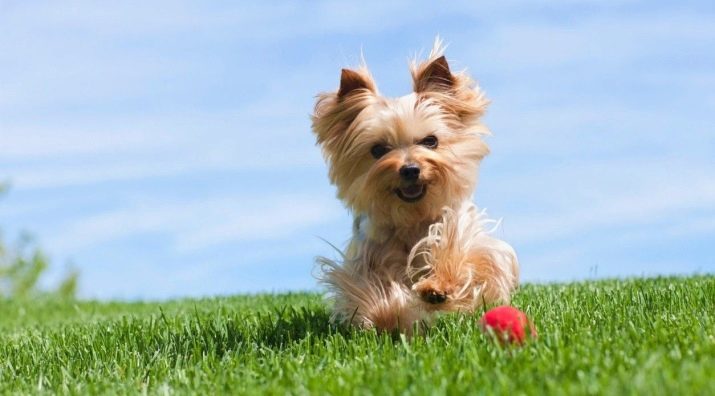
Here are the recommendations that experts give in educating these little "energizers."
- Classes should be held in comfortable conditions, that is, in the right place and at the right time. Doggie will listen to you carefully only if he has previously eaten and is in good mood. The first lessons should be held at home where there are no strangers, then it will be easier for your pet to concentrate.
- Before you begin to train a York, become a leader in his eyes. If this does not happen, then the dog will take this role upon himself, and all your teams will pass by.
- To achieve credibility in a relationship with a York, do not let him into your bed - he must know his place. Boys are especially fond of demonstrating their leadership - it is believed that they are more arrogant and more active than girls. Unfortunately, many owners violate this recommendation, which is why subsequently they have problems in raising a pet. It is also important that the dog eat only from his bowl and not beg, hoping to get a tidbit from the general table.
- Use the “gingerbread” tactics, that is, reward your pet for correctly executed commands with delicious treats. The “stick” should not be connected - the physical impact in the upbringing of the dog will not benefit.
- It is important that the pet abides by the established rules with all households. To do this, all family members must adhere to a single line of behavior in communication with the dog. Explain to the children that if they secretly spoil the dog with food from the table, then all upbringing will go down the drain.
- Listening to commands, the dog looks at the owner’s gestures no less carefully. Think through them so as not to mislead the dog, making hand movements "off topic."
- Prohibiting commands must be executed implicitly. Say them in the sternest voice, and if the dog is on a walk, then you should pull the leash. In some cases, this can save the life of a pet, for example, if he rushes into the car.
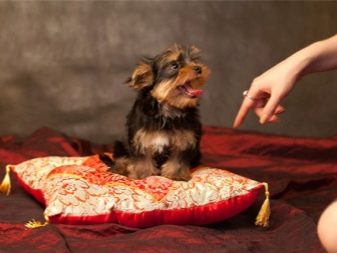
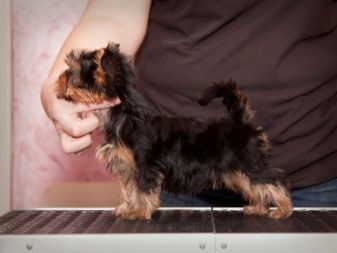
How to accustom to the toilet?
Now consider the individual skills that the York Terrier gains in the first place. Yorkies are so homely that they even go to the toilet not on the street, but in the tray. You can teach him how to relieve himself on the street, but first, look at his behavior. If he categorically does not want to do this in the fresh air and suffers before returning home, then, most likely, the walks themselves are not interested in him.
To change this situation, you need to make his leisure time on the street more diverse - bring along toys, engage him in games.
It’s easier to train a dog to cope on the street, if you take the baby out for a walk right after waking up. Also, a good time will be the moment after eating. If in the summer you take him to the toilet outside, and in winter in bad weather you are lazy to do this, then it will be difficult for the dog to change his habit. The mixed option is less preferable - Yorkies often adhere to one way to relieve themselves. Therefore, the owner should immediately decide how your dog will go to the toilet.
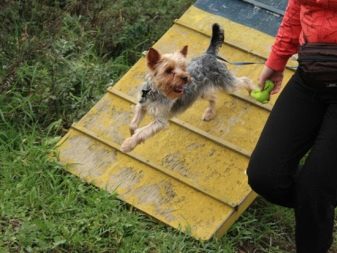

Training
Teaching a dog to teams is best entrusted to a specialist. Training courses allow you to effectively correct behavior, in these classes dogs learn both simple commands and more complex ones. In addition, dog handlers will give you tips on raising a pet for the future.
To raise an animal on your own, you have to stock up on free time and tremendous patience.
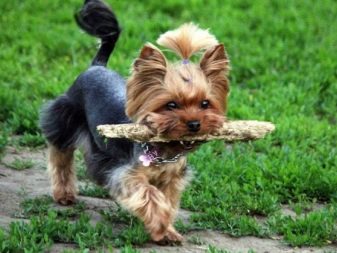
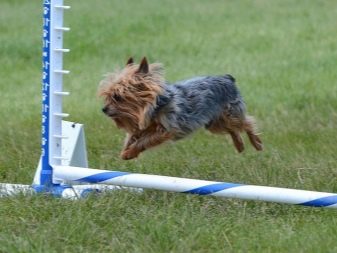
Start classes only with a positive attitude, repeat the same commands every day, and you will certainly succeed.
- Nickname. She is given to the dog as soon as she appeared in your house, and remains with her forever. Do not confuse the animal by calling it a different name. It is unacceptable to distort a nickname or call a dog by different names.
- "Fu". This command is by no means an analogue of the word impossible. It is used exclusively in cases where the dog is trying to pick up something from the ground and eat.
- "It is impossible". This command has a broader meaning, it gives a ban on the commission of certain actions.Say it in a demanding tone, but do not go on a cry.
- "A place". Training for this team begins on the day York appears in the house. When he falls asleep, take him to a dog’s place and carefully lay him down, saying in a calm tone: "A place". If the dog tries to get out of there, repeat the action and say a command with a more severe tone.
- "To me". Say the phrase, showing the dog a tasty treat. After the command, give the dog a well-deserved reward.
- "Sit". When the dog is on a leash, tell her: "Sit!", While slightly pulling the leash up. After completing the command, reward the pet with a tidbit.
- “Lie down”. First show the dog a tasty treat, and then lower your hand down and lead it forward. When York tries to take it out of hand, give this command and, after waiting for its execution, give the dog a reward.
- "Nearby". Having voiced this word, slightly pull the leash towards you so that the dog keeps up with you on the left. Say this command as soon as you see the dog trying to run away from you.
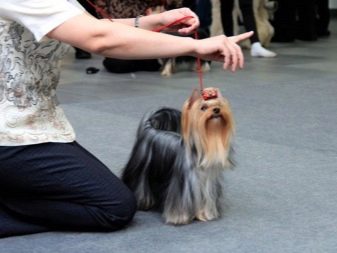
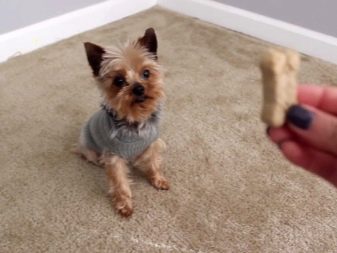
Behavior
So that your walks do not turn into chaos, the dog must learn that on the street he must strictly obey his master. Let the pet learn that running away and rushing at passers-by is not permissible.
If standard commands are still poorly executed, then whenever the dog behaves improperly, stop and stand still. Do not forget to hold the leash firmly without yanking it - the dog will not be able to move on. You need to go at a calm measured pace. Keep in mind that if you run, the dog will follow you with even greater speed.
The first walks are better not to delay so that your four-legged friend does not get bored.
Let the time for walks increase gradually. Within a month, your pet's behavior on the street should normalize.
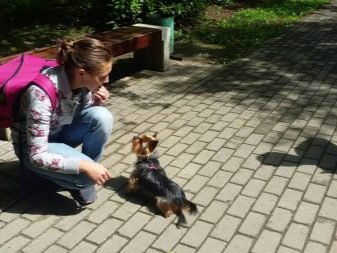
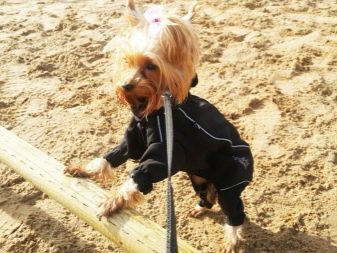
Monthly team training
Training York is not as difficult as other breeds, such as the German Shepherd or Bloodhound. It is important to earn the authority of your baby so that he clearly knows "who is the boss in the house."
- In 1-2 months York must learn its nickname. Also teach him the most important teams “to me” and “place”.
- In 2-3 months it’s time for the baby to master the collar, learn to walk in it, carry out the “sit” and “walk” commands.
- In 3-4 months Yorkers have a good understanding of the “lay” and “close” commands.
- In 4-5 months dog breeders are advised not to learn new teams, but to hone old ones well.
- Half year it’s time for puppies to learn to stand and take.
- Age 7-8 months suitable to learn how to cast a “voice”, as well as perform the “aport” command.
- At 10 months it's time to go to the site where other dogs are training. There you can teach your pet new teams, chat with other owners of York Terriers, learn the secrets of successful training and exchange valuable experience.
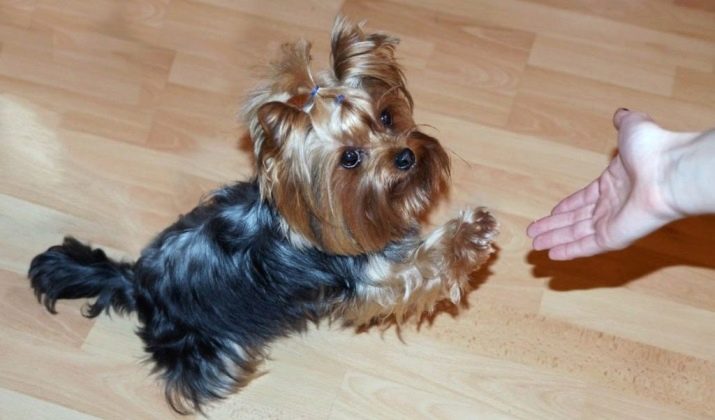
Experts recommend conducting classes if possible in a playful way. This will allow the pet to absorb information faster and start doing what you want.
See the next video for more on york training.








































